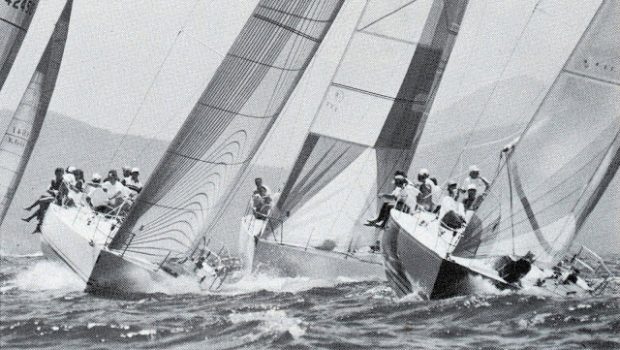Why I Am Leaving the Rat Race
Published on August 28th, 2018
The health of our sport should always be a priority – the next generation deserves it. Yet, too often we care more about evolving, a trait that whittles away at who can, or wants to, participate. As Eric Swenson writes in 1986 for Sailing World, this trend in our sport has roots.
I am the owner, skipper and chief helmsman of the Frers 51 Toscana, an IOR racing machine. As such, I am a nearly extinct animal, but now I happily add my bones to the IOR graveyard and move on to a better state of being. I do so for several reasons, one of which is that I think IOR racing, as I have known and loved it since the rule came into effect 15 years ago, is a mess-and probably dying.
When I first met her in 1979, Toscana was called Blizzard and was not only the flagship of the British Admiral’s Cup team, but arguably the fastest-for-rating IOR yacht in the world. We – meaning my crew, who were my friends, not my employees – had sailed a Swan 47 on a transatlantic race from Marblehead to Cork, Ireland, where we accepted the Irish Cruising Club’s invitation to join its Golden Jubilee Cruise.
It turned out to be seven days of intensive partying, interrupted daily by a few hours of sailing along a coast that for sheer beauty makes even Maine take a back seat. However, it became necessary to give our livers a rest, so we sailed off to England where we raced in Cowes Week, a 900-boat, 19-nation regatta, and later took fourth in that year’s infamous Fastnet Race.
In Cowes, we fell in love with Blizzard because she had the gorgeous lines of all Frers yachts and was fast enough to wipe out Dennis Conner, sailing for the owner of Williwaw. One thing led to another – including enthusiastic pressure from my friends/crew – and I bought Blizzard and gave her the name Toscana, which has been the name of all of my boats since 1965, when my wife and I were married in Florence, the capital of Tuscany.
All this may seem irrelevant, but keep it in mind.
We have not set the IOR world aflame, but we have helped keep it warm. We have won our share – such things as the Northern Ocean Racing Championship, the New York Yacht Club Regatta, the Roger Sherman Trophy, and so on. My crew costs me a few cases of beer and some deli food for day races, and my wife cooks up a storm of frozen food for distance races. That’s it: no free air tickets, no hotel rooms, expense money, or under-the-table green stuff.
Our philosophy has been that we get a bigger thrill out of our occasional triumphs over the semi-and sometimes totally professional competition we race against than they do out of beating us. We’ve had fun.
Well, IOR winners no longer have sentimental names. They are called things like Razzle Dazzle; Shoot low; They’re Riding Chickens; or Fujimo. (We all know it’s not Japanese and it is about as cruddy as a name can get.) The fun is no longer there, and I am doing something to recover it.
After eight years of racing – a remarkable competitive longevity for an IOR race – Toscana can no longer keep pace with the newer, lighter, less comfortable and more fragile IOR yachts except in flat seas. (We did well in the 1986 Bermuda Race because it was largely a drifter with maximum wave heights of six inches, and because our navigator, Bob Congdon, put us in precisely the right spots. We band of friends sailed it well too.)
All this leaves me with three alternatives:
(1) Continue to race Grand Prix where, no matter how good our sails, how clean out bottom, how well we sail, we will inevitably sink down in the standings;
(2) Literally throw away the hull of my fast, lovely, rugged yacht, and spend $700,000 on a new, state-of-the-art, breakable 50-footer (a size I am devoted to) which would be uncruisable, have four-foot headroom and, in turn, be outbuilt in two years; or
(3) Do what I am doing – convert Toscana into a cruiser/racer and race henceforth mostly in IMS or PHRF divisions and, oh bliss, cruise with speed and comfort.
For those who question the phrase “throwaway,” consider the facts: Toscana cannot be sold as a racing yacht; she’s made of that old-fashioned, heavy-material called aluminum, which denied her any hope of competing with new yachts made of exotic compounds that permit the concentration of an extraordinary percentage of total weight in the center and low.
Nor could Toscana be sold as a cruising boat. Below, she is an open aluminum tube lined only with pipe berths and furnished with a stove, a small nav desk, no ports or lights, ventilation by hatches only, no refrigeration, no hot water, no privacy, and a head so small, that one of my broad-shouldered companions has to sit on the pot twisted like a piece of taffy. Beneath all of this is a three-inch deep bilge. We do have headroom, lots of it, which none of the IOR yachts do.
Possibly I could have sold Toscana for much less than she was worth to someone who would be willing to put in a great deal more to fit her out for cruising – but why would anyone want to do that when he could buy a cruising boat built from scratch for about the same price?
In short, my yacht, my beautiful and modestly celebrated yacht is, as that Great Briton Johnnie Coote called it, “an unbankable asset” – a throwaway. However, I am going to change that.
Before I reveal the details, there are some points to be made about what is happening to IOR racing. It is, at best, sadly sick. Racers are leaving it. The 1986 Bermuda Race had 60 IOR entrants compared to 150 a few racers ago, and only one from overseas: Backlash was sailed 6000 miles by the Herring family to get there. On the other hand, there were the 120 IMS entries.
The SORC is badly shrunken, as is the Annapolis-Newport, the Halifax, the Vineyard, and the rest. This past summer’s international Onion Patch Series was a joke. No foreign teams entered, not even a Canadian or Bermudian. The reasons for the decline of the IOR seem clear to me.
As written, the rule has been around long enough that there are few if any changes left to be wrung on hull shape. All that is left for the designers is to design around more and more exotic and expensive materials. Carbon fiber-epoxy compounds are in – for now.
But they cost like hell. They produce faster results because a featherweight hull permits ballasting that creates a stiffer boat that can carry more sail in more wind and dramatically damp down hobbyhorsing in a seaway. Hence more speed. It also helps to have titanium rudders (I have one; they might as well be made of platinum), a gaping hole where the transom should be, and freeboard of the sort that makes a 50-footer look like a Concordia.
Low free-boards are all the rage because they reduce weight and windage above the waterline. They also reduce headroom to such an extent that a superb ocean sailor like Walter Hanson (remember Recluta?) reportedly refuses to go below on his own yacht for any reason whatsoever – which makes overnights tiresome. In fact, rumor has it that Walter is bagging it and selling his all-winning Midnight Tiger and quitting. A great loss to the sport. Sport?
The new materials and the construction techniques they mandate keep changing. A hull is no longer state-of-the-art after two seasons. After that, the owner must strip the hull of rig and gear, throw it away, and build a new one to remain competitive – to stay in the game.
More and more, those who want to stay in the game are not sailors as I understand the term. They are superannuated yuppies playing a power game. As Jay Hansen of North Sails says in North News – and he’s quoting an owner – “Yachting is the power sport. And I don’t mean just the Cup races.”
Apparently winning means power to them, so money, and even their own participation often doesn’t matter.
Hansen described the crew of a boat he raced on in the SORC last winter thus: The helmsman was an Olympic medallist who runs a North sail loft; the chute trimmer was a North designer; grinding was production manager of a mast company; trimming the main was a North sales manager; Hansen himself was the tactician, and he is North’s business manager. The owner? He was on the rail. “He didn’t do anything.”
That’s the way to win in IOR, and I say the hell with it.
My crew are my friends. My stepson does most of the shouting and the bow work; my best trimmer, Sherry Jagerson, first came aboard for the 1976 Bermuda Race, claiming to be a cook. She hasn’t been allowed to cook since, but is a superb trimmer. My tactician is an advertising executive. My grinders both work in securities, one in bonds, one in stocks. My best all-around man and the life of the crew sells insurance out of Marblehead. My navigator, it’s true, is the national sales director of Ockam Instruments, but he was sailing with me when he was a freelance photographer, snapping busloads of New England autumn leaf-watchers for Tauck Tours, long before he went to Ockam.
Until recently we have been able to win often enough to provide us with thrills and a lot of laughs, even against boatloads like the one Hansen describes above. (How does the owner of that boat feel when he steps up to receive his cup at the awards ceremony, after spending the whole race watching?) When I lend my boat to someone else to race – usually because my daughters always seem to graduate from school during Block Island Race Week – and he wins, the trophy goes home with him.
Another fact is observable: The new materials, in combination with the new IOR rules, have not produced safe boats.
I watched while Infinity, by all odds the fastest 50-footer alive, had a rudder bearing come loose from the hull in a 25-knot breeze off Newport. (She had a big lead when she had to withdraw, and we weren’t more than three miles from the start.) Her carbon fiber-epoxy hull apparently sponges water into the hull core to an extent that she has to be drained between races. It’s also reported that when she was lifted for draining in Newport, here hull cracked.
The new Springbok, another super-fast 50-footer, also had a rudder bearing come adrift in the same 25-knot breeze. (Springbok went on to lose her mast at the Kenwood Cup in Hawaii. She was being raced by Dennis Conner.)
Should boats like these be allowed in IOR races? No comment. They are allowed, and boats like Toscana – once state-of-the-art and built like Sherman tanks for offshore racing – can’t beat them except when, as in the Newport races mentioned above, they come apart. So, as much fun as it has been, “power game” racing is not for me.
Toscana is in the hands of Jim McCurdy of McCurdy and Rhodes and Jono Billings of the Jamestown Boat Yard. She’s having a cruising interior installed: two heads, one with a stall and a shower (doubling as a foul weather gear hanging locker); two private staterooms and one public; a dinette with a real table; refrigeration; hot water; a racy deckhouse with ports and lights and vents; a luxurious navigation area and a galley with a window.
My wife says she will again come sailing with me.
We will have a demountable cruising rig – roll-up jib, fully battened main with instant sailcover, perhaps a hydraulic winch for the main halyard and anchor hauling. Of course, the racing rig will remain untouched, as will the deck layout and racing sails. And the bulkheads for all those luxurious quarters down below will be Nomex, and bunks will be light and adjustable at sea. We will be a super-light and super-fast IMS yacht.
Do I see future warnings for IMS in what I am doing? Yes, but the lessons of what has happened to IOR can be read by those who will command the future of IMS, and appropriate action can be taken before it goes the way of IOR. The banning of super-expensive, exotic materials for both hull and sails should be considered. Strict sail inventory limitation and stowage location is in place and should be policed. Keep the professionals off the wheel during races. And all 50-footers must be required to have refrigeration and two heads. My wife says I already have the latter.
I will get a new IOR rating, for old times’ sake. Who knows, we may have discovered a new secret (perhaps heavy is faster!) and will go on to win in the “power sport.” Meanwhile, let us not rule out incentives for experimentation in materials and design. As in auto racing, how about an all-out, professional, Grand Prix circuit?
When I was younger and unworried about heirs, I raced sports cars. We raced under the rules of all-amateur Sports Car Club of America and felt ourselves no less grand than the Grand Prix racers who did Monza, Monte Carlo, Indianapolis, Goodwood, and Gibraltar (are you listening Peter Ustinov?). For now, farewell IOR. Change, or R.I.P.
Editor’s note: The article on the Sailing World website said it was published in 2004 but we have since learned it was the fall of 1986. This introduction of this story was updated to reflect this new information.









 We’ll keep your information safe.
We’ll keep your information safe.